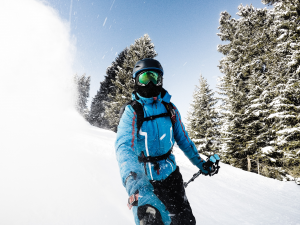Experience-based video stabilization use cases

Imagine that a drone, smartphone or action camera is used on a hiking and skiing excursion in the mountains. In such case, the highest degree of stabilization might feel too rigid, like the film was shot by a robot. Still, more stabilization may be necessary on an action camera used while skiing or a drone flying around in heavy wind than on a smartphone held in your hand while you slowly and calmly walk forward on a hike. That being said, while hiking, you could easily step on uneven ground, lose your balance, or need to quickly pan to record some fascinating wildlife you hear behind you before the moment is lost.
In the examples above, different types of cameras in motion needed different degrees of video stabilization because of their different use cases. This means that a one-size-fits-all approach to video stabilization will fall flat. But it’s not just about customizing the degree of video stabilization for each different camera in motion. The same smartphone, drone or action camera is likely to be used in different situations. What if you want to use the same camera for both the hiking and skiing? What if you’re walking with a smartphone and then suddenly need to run or turn?
Why video stabilization needs to be more flexible and adaptable
To meet these needs, your camera in motion needs to be adaptable in terms of video stabilization not only before it’s used but also out in the field. Sometimes, you may also need to use the same device for both information gathering and experience-based use cases. Take the case of a law enforcement bodycam that needs to capture information in the heat of the moment and then present realistic video evidence after the fact.
As a result, next-gen video stabilization algorithms will need to be increasingly flexible and adaptable to different uses to create just the right balance of video stabilization power. Many experience-based video stabilization use cases demand that we reimagine the way we perceive video quality and create a more realistic experience that approximates a professional human cameraperson.
For more insights on how our very definition of what the best video stabilizer is must change and why more flexibility is needed to meet tomorrow’s needs, check out our guide, “Reimaging video stabilization quality”. Don’t hesitate to get in touch with us and engage in dialogue on your view of present and future video capabilities. For inspiration, insights and best practices for the next generation of video stabilization, enter your email address below and subscribe to our newsletter.



